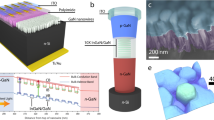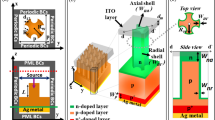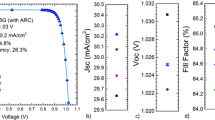Abstract
Light management is of great importance in photovoltaic cells, as it determines the fraction of incident light entering the device. An optimal p–n junction combined with optimal light absorption can lead to a solar cell efficiency above the Shockley–Queisser limit. Here, we show how this is possible by studying photocurrent generation for a single core–shell p–i–n junction GaAs nanowire solar cell grown on a silicon substrate. At 1 sun illumination, a short-circuit current of 180 mA cm–2 is obtained, which is more than one order of magnitude higher than that predicted from the Lambert–Beer law. The enhanced light absorption is shown to be due to a light-concentrating property of the standing nanowire, as shown by photocurrent maps of the device. The results imply new limits for the maximum efficiency obtainable with III–V based nanowire solar cells under 1 sun illumination.
This is a preview of subscription content, access via your institution
Access options
Subscribe to this journal
Receive 12 print issues and online access
$209.00 per year
only $17.42 per issue
Buy this article
- Purchase on Springer Link
- Instant access to full article PDF
Prices may be subject to local taxes which are calculated during checkout



Similar content being viewed by others
References
Tian, B. Z. et al. Coaxial silicon nanowires as solar cells and nanoelectronic power sources. Nature 449, 885–888 (2007).
Law, M., Greene, L. E., Johnson, J. C., Saykally, R. & Yang, P. D. Nanowire dye-sensitized solar cells. Nature Mater. 4, 455–459 (2005).
Kayes, B. M., Atwater, H. A. & Lewis, N. S. Comparison of the device physics principles of planar and radial p–n junction nanorod solar cells. J. Appl. Phys. 97, 114302 (2005).
Spurgeon, J. M. et al. Flexible, polymer-supported, Si wire array photoelectrodes. Adv. Mater. 22, 3277–3281 (2010).
Fan, Z. et al. Three-dimensional nanopillar-array photovoltaics on low-cost and flexible substrates. Nature Mater. 8, 648–653 (2009).
Kempa, T. J. et al. Single and tandem axial p–i–n nanowire photovoltaic devices. Nano Lett. 8, 3456–3460 (2008).
Chuang, L. C. et al. Critical diameter for III–V nanowires grown on lattice-mismatched substrates. Appl. Phys. Lett. 90, 043115 (2007).
Glas, F. Critical dimensions for the plastic relaxation of strained axial heterostructures in free-standing nanowires. Phys. Rev. B 74, 121302 (2006).
Tsakalakos, L. et al. Silicon nanowire solar cells. Appl. Phys. Lett. 91, 233117 (2007).
Goto, H. et al. Growth of core–shell InP nanowires for photovoltaic application by selective-area metal organic vapor phase epitaxy. Appl. Phys. Express 2, 035004 (2009).
Garnett, E. C. & Yang, P. Silicon nanowire radial p–n junction solar cells. J. Am. Chem. Soc. 130, 9224–9225 (2008).
Wallentin, J. et al. InP nanowire array solar cells achieving 13.8% efficiency by exceeding the ray optics limit. Science 339, 1057–1060 (2013).
Tian, B. Z. & Lieber, C. M. Design, synthesis, and characterization of novel nanowire structures for photovoltaics and intracellular probes. Pure Appl. Chem. 83, 2153–2169 (2011).
Dalmau-Mallorqui, A., Epple, F. M., Fan, D., Demichel, O. & Fontcuberta i Morral, A. Effect of the pn junction engineering on Si microwire-array solar cells. Phys. Status Solidi 209, 1588–1591 (2012).
Tsakalakos, L. et al. Strong broadband optical absorption in silicon nanowire films. J. Nanophot. 1, 013552 (2007).
Zhu, J. et al. Optical absorption enhancement in amorphous silicon nanowire and nanocone arrays. Nano Lett. 9, 279–282 (2009).
Mariani, G. et al. Patterned radial GaAs nanopillar solar cells. Nano Lett. 11, 2490–2494 (2011).
Muskens, O. L., Gomez-Rivas, J., Algra, R. E., Bakkers, E. P. A. M. & Lagendijk, A. Design of light scattering in nanowire materials for photovoltaic applications. Nano Lett. 8, 2638–2642 (2008).
Kosten, E. D., Warren, E. L. & Atwater H. A. Ray optical light trapping in silicon microwires: exceeding the 2n2 intensity limit. Opt. Express 19, 3316–3331 (2011).
Callahan, D. M., Munday, J. N. & Atwater H. A. Solar cell light trapping beyond the ray optic limit. Nano Lett. 12, 214–218 (2012).
Kelzenberg, M. D. et al. Enhanced absorption and carrier collection in Si wire arrays for photovoltaic applications. Nature Mater. 9, 239–244 (2010).
Diedenhofen, S. et al. Strong geometrical dependence of the absorption of light in arrays of semiconductor nanowires. ACS Nano 5, 2316–2323 (2011).
Kwanyong, S. et al. Multicolored vertical silicon nanowires. Nano Lett. 11, 1851–1856 (2011).
Van Vugt, L. L., Zhang, B., Piccione, B., Spector, A. A. & Agarwal, R. Size-dependent waveguide dispersion in nanowire optical cavities: slowed light and dispersionless guiding. Nano Lett. 9, 1684–1688 (2009).
Cao, L. et al. Engineering light absorption in semiconductor nanowire devices. Nature Mater. 8, 643–647 (2009).
Brönstrup, G. et al. A precise optical determination of nanoscale diameters of semiconductor nanowires. Nanotechnology 22, 385201 (2011).
Heiss, M. & Fontcuberta i Morral A. Fundamental limits in the external quantum efficiency of single nanowire solar cells. Appl. Phys. Lett. 99, 263102 (2011).
Kempa, T. et al. Coaxial multishell nanowires with high-quality electronic interfaces and tunable optical cavities for ultrathin photovoltaics. Proc. Natl Acad. Sci. USA 109, 1407–1412 (2011).
Nelson, J. The Physics of Solar Cells (Imperial College, 2003).
Oskooi, A. F. et al. MEEP: a flexible free-software package for electromagnetic simulations by the FDTD method. Comp. Phys. Comm. 181, 687–702 (2010).
Kupec, J. & Witzigmann, B. Dispersion, wave propagation and efficiency analysis of nanowire solar cells. Opt. Express 17, 10399–10410 (2009).
Cao, L. Y. et al. Semiconductor nanowire optical antenna solar absorbers. Nano Lett. 10, 439–445 (2010).
Leatherdale, C. A., Woo, W. K., Mikulec, F. V. & Bawendi, M. G. On the absorption cross section of CdSe nanocrystal quantum dots. J. Phys. Chem. B 106, 7619–7622 (2002).
Henry, C. H. Limiting efficiencies of ideal single and multiple energy gap terrestrial solar cells. J. Appl. Phys. 51, 4494–4500 (1980).
Araújo, G. L. & Marti, A. Absolute limiting efficiencies for photovoltaic energy-conversion. Solar Ener. Mater. Solar Cells 33, 213–240 (1994).
Polman, A. & Atwater H. A. Photonic design principles for ultrahigh-efficiency photovoltaics. Nature Mater. 11, 174–177 (2012).
Kempa, T. et al. Coaxial multishell nanowires with high-quality electronic interfaces and tunable optical cavities for ultrathin photovoltaics. Proc. Natl Acad. Sci. USA 109, 1407–1412 (2012).
Campbell, P. & Green, M. A. The limiting efficiency of silicon solar cells under concentrated sunlight. IEEE Trans. Electron. Device Lett. 33, 234–239 (1986).
Nelson, J. The Physics of Solar Cells (Imperial College Press, 2003).
Luque, A. The confinement of light in solar cells. Solar Ener. Mater. 23, 152–163 (1991).
Yablonovitch, E. & Cody, G. D. Intensity enhancement in textured optical sheets for solar cells. IEEE Trans. Electron. Device Lett. 29, 300–305 (1982).
Shockley, W. & Queisser H. J. Detailed balance limit of efficiency of p–n junction solar cells. J. Appl. Phys. 32, 510–519 (1961).
Uccelli, E. et al. Three-dimensional twinning of self-catalyzed GaAs nanowires on Si substrates. Nano Lett. 11, 3827–3832 (2011).
Krogstrup, P. et al. Structural phase control in self-catalyzed growth of GaAs nanowires on silicon (111). Nano Lett. 10, 4475–4482 (2010).
Casadei, A. et al. Doping incorporation paths in catalyst-free Be-doped GaAs nanowires. Appl. Phys. Lett. 102, 013117 (2013).
Colombo, C., Heiß, M., Graetzel, M. & Fontcuberta i Morral, A. Gallium arsenide p–i–n radial structures for photovoltaic applications. Appl. Phys. Lett. 94, 173108 (2009).
Zhao, J. et al. 19.8% efficient ‘honeycomb’ textured multicrystalline and 24.4% monocrystalline silicon solar cells. Appl. Phys. Lett. 73, 1991–1993 (1998).
Green, M. A., Emery, K., Hishikawa, Y., Warta, W. & Dunlop, E. D. Solar cell efficiency tables (version 41). Prog. Photovolt. 21, 1–11 (2013).
Acknowledgements
This research was funded by the ERC starting grant UpCon and by SNF (project nos 137648, 143908) and NCCR-QSIT. A.F.i.M. thanks STI for the 2011 end-of-year fund for MiBoots robots used in the scanning photocurrent experiment. A.F.i.M. and M.H. thank A. Dalmau-Mallorqui and F.M. Epple for experimental support. The authors also thank C.B. Sørensen and M.H. Madsen for assistance with MBE growth. This work was supported by the Danish National Advanced Technology Foundation (project 022-2009-1), a University of Copenhagen Center of Excellence, and by the UNIK Synthetic Biology project.
Author information
Authors and Affiliations
Contributions
P.K. grew the nanowire p–n junctions. H.I.J. performed I–V characterization and fabricated the device, with help from J.V.H. and M.A. M.H. and O.D. performed the FDTD calculations. M.H. realized the photocurrent mappings and the external quantum efficiency measurements. A.F.i.M. and P.K. conceived and designed the experiments. A.F.i.M., J.N. and M.A. supervised the project. A.F.i.M., H.I.J., P.K. and M.H. composed the figures and wrote the manuscript. All authors discussed the results and commented on the manuscript.
Corresponding authors
Ethics declarations
Competing interests
The authors declare no competing financial interests.
Supplementary information
Supplementary information
Supplementary information (PDF 1097 kb)
Rights and permissions
About this article
Cite this article
Krogstrup, P., Jørgensen, H., Heiss, M. et al. Single-nanowire solar cells beyond the Shockley–Queisser limit. Nature Photon 7, 306–310 (2013). https://doi.org/10.1038/nphoton.2013.32
Received:
Accepted:
Published:
Issue Date:
DOI: https://doi.org/10.1038/nphoton.2013.32
This article is cited by
-
Low-dimensional wide-bandgap semiconductors for UV photodetectors
Nature Reviews Materials (2023)
-
SiNW Design by Induced Current to Achieve Excellent Absorption for Linearly Polarized Photodetector
Silicon (2023)
-
Sub-nanometer mapping of strain-induced band structure variations in planar nanowire core-shell heterostructures
Nature Communications (2022)
-
Characterization of the remediation of chromium ion contamination with bentonite by terahertz time-domain spectroscopy
Scientific Reports (2022)
-
Development and characterization of photovoltaic tandem-junction nanowires using electron-beam-induced current measurements
Nano Research (2022)



